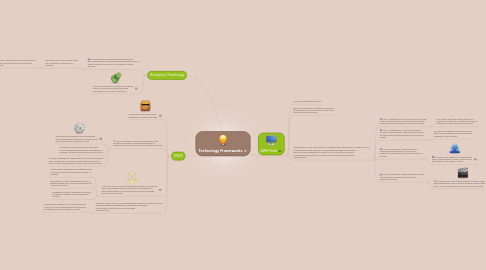
1. TPACK
1.1. TPACK stands for Technological Pedagogical Content Knowledge
1.2. TPACK identifies technological, pedagogical, and content knowledge as the three primary areas of knowledge necessary for an effective teacher to possess
1.2.1. Technological Knowledge involves knowledge about technology including how it works, how to use it, and what the technology can do
1.2.2. Pedagogical Knowledge involves knowledge about different teaching theories and methods of teaching. It answers the question of how to teach.
1.2.3. Content Knowledge is the knowledge a teacher requires about their subject area. For example, a math teacher must know how to solve all the problems covered in the math curriculum.
1.3. TPACK also focuses on the intersections between each of these areas of knowledge with one other area of knowledge. This encourages teacher to consider how the areas of knowledge interact with each other.
1.3.1. Technological-Pedagogical Knowledge focuses on how technology can transform methods of teaching
1.3.2. Technological-Content Knowledge focuses on how technology can be used to think about and understand content
1.3.3. Pedagogical-Content Knowledge focuses on the specific methods of teaching specific content.
1.4. Finally, TPACK highlights the intersection between all three areas of knowledge to highlight that all areas of knowledge interact with all the other areas of knowledge simultaneously
1.4.1. Technological-Pedagogical-Content Knowledge (TPACK) focuses on how technology transforms the methods of teaching specific content
2. Philosophy of Teachnology
2.1. The Philosophy of Teachnology is a teacher's own personal philosophy on how the believe technology can be used to enhance, transform, or contribute to student learning.
2.1.1. The Philosophy of Teachnology arises out of a teacher's Philosophy of Teaching.
2.1.1.1. A teacher's Philosophy of Teaching concerns a teacher's own beliefs about best teaching practices.
2.2. A teacher's Philosophy of Teachnology should, ideally, be informed by other technology frameworks such as TPACK and SAMR.
3. SAMR Model
3.1. SAMR is an evaluative framwork
3.2. the use of technology in teaching is evaluated for the level of improvement and change to the task the technology affords
3.3. SAMR classifies the use of technology in the classroom along four levels. As the level increases, the level of change the technology allows and the level of student engagement increases as well. The first two levels are classified as enhancement, and the second two levels are classified as transformation.
3.3.1. Level 1 Substitution- technological tools are simply used as a substitute for more traditional tools when performing a task that does not require technology
3.3.1.1. Ex. a teacher performs math problems on a smart board, rather than a chalk board, without making use of the board's special features
3.3.2. Level 2 Augmentation- technology is used to perform a task which was done before technology, but the use of the technology has some functional benefit
3.3.2.1. Ex. students complete "mad minutes" online, rather than on paper, and receive immediate feedback on their progress
3.3.3. Level 3 Modification- Tasks done before technology are performed, but the use of technology enables significant transformation of the task
3.3.3.1. Ex. online social networks for education are used to allow students to work collaboratively with students from another country
3.3.4. Level 4 Redefinition- Technology allows for new tasks which would have not been possible without technology
3.3.4.1. Ex. students use video editing software to create a high quality presentation which features student filmed footage, music, text, and images on social issue discussed in class
